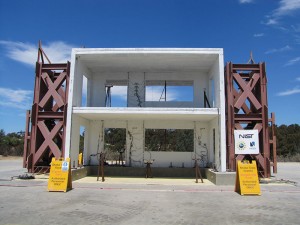Insight into the new Limit Design method for special reinforced masonry shear walls – what it offers, how it was developed, and a glimpse at possible future developments.
“Limit Design is a bold step for masonry engineering and it marks it as an even more significant structural material.” That may be my favorite comment from my tenure as the MSJC Chair. It came upon the successful balloting and adoption of the new Appendix C – Limit Design of Masonry.

Research was part of the process used to develop Limit Design. This full scale, 2-story masonry specimen with irregular openings was tested on the shake table at UC San Diego as part of a NEES/NIST funded project. Courtesy of Richard Klingner.
So What is ‘Limit Design’?
If masonry walls have no openings, analyzing them is simple. Add a door or a window opening and it still isn’t difficult. However, multistory shear walls with irregular openings can pose analytical challenges, especially when coupled with the requirements of higher seismic zones. The Masonry Standards Joint Committee Code – TMS 402/ACI 530/ASCE5 (MSJC), provides several options for the design of special reinforced masonry shear walls both through allowable stress design (ASD) and strength design (SD) methods. These forced-based methods usually work well, but can be difficult to apply to irregular wall configurations, especially those controlled by shear…enter “Limit Design.”
Limit Design is a performance-based option for such structures, based on a more global look at the wall rather than just the segments comprising that wall. Limit Design, while still using the design base shear now required by ASCE7, permits the designer to distribute that shear internally according to the plastic capacities of the segments comprising a wall, rather than according to their elastic stiffnesses.
The Limit Design appendix takes an approach that is very similar to that taken with existing seismic design. Basic steps include (Lepage, et al. Eleventh North American Masonry Conference):
- Performing a conventional seismic analysis,
- Determining the controlling yield mechanism,
- Checking the lateral strength of yield mechanism,
- Checking the deformation capacity of yield mechanism.
The method offers an alternative to the special boundary element and maximum reinforcement provisions in the code since the method confirms masonry ductility for the structure being analyzed. It focuses the design on the areas of the structure that are likely to experience high deformation demand during seismic events.
According to Thomas Gangel, a long-time member of the MSJC and former chair of the Seismic Subcommittee, “The code in Appendix C gives us a rational method to design cantilever shear walls with openings. That is something that we have never really had in the MSJC before now. The MSJC appendix limit state method requires the designer to anticipate the behavior of the wall during a seismic event, and provides design and detailing guidance to help him achieve a wall design that will perform in accordance with the anticipated behavior. It provides a glimpse of where masonry engineering is heading in the future.”
How We Achieved ‘Limits’
In the 2011 MSJC cycle, a new concept for the Committee was instituted – task groups – one of which was called the “Ductility Demand Task Group”. Task groups were created to permit participation in the MSJC process from people who had an interest in working on a specific, focused topic or task. Task group members are given a single task and asked to dig into it in depth, then bring recommendations back into the traditional MSJC structure for additional vetting and balloting. The task group provides a depth to the topic that isn’t always possible in subcommittees or main committees which, by necessity, must deal with multiple items.
The Ductility Demand task group was chaired by Steven Dill, who assembled a broad-base group of seismic and masonry experts as members. Richard Klingner was the chair of the Seismic Subcommittee where the recommendations of the task group eventually came to roost for additional development and balloting. During the 2011 cycle, the Ductility Demand task group further focused to Limit Design and submitted their proposed provisions to the Seismic Subcommittee. Those provisions were the genesis of Limit Design. This ambitious work on special reinforced masonry shear walls carried into the 2013 MSJC cycle where it was successfully adopted into Appendix C – Limit Design of Masonry.
So What is Next for Limit Design?
Richard Bennett, has been appointed as the new Chair of the 2016 MSJC Committee. Dick has every intention of continuing the development of Appendix C by encouraging input from users and from the research community which will be used to refine MSJC Limit Design. The ultimate goal is to continue to work with other structural groups to evolve the appendix into a displacement-based design option for masonry structures not just for special reinforced masonry shear walls. The 2013 MSJC edition of Limit Design is a good first step toward this goal.▪
References
Thomas A. Gangel, P.E., Principal Wallace Engineering Structural Consultants, Inc., Tulsa, OK
Steven Dill, S.E., Principal, KPFF Consulting Engineers, Seattle, WA
Richard Klingner, Ph.D., P.E., Emeritus Professor of Civil Engineering, The University of Texas at Austin
Richard Bennett, Ph.D., P.E., Professor, University of Tennessee, Department of Civil Engineering
Seismic Design of Reinforce Masonry Walls: Current Methods and Proposed Limit-Design Alternative; Lepage, et al. Eleven North American Masonry Conference.
